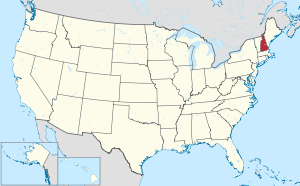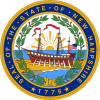Merrimack County, New Hampshire
Merrimack County | |
|---|---|
U.S. county | |
 Merrimack County Courthouse, 2019 | |
 Location within the U.S. state of New Hampshire | |
 New Hampshire's location within the U.S. | |
| Coordinates: 43°18′N 71°41′W / 43.3°N 71.68°W | |
| Country | |
| State | |
| Founded | 1823 |
| Named for | Merrimack River |
| Seat | Concord |
| Largest city | Concord |
| Area | |
| • Total | 955.0 sq mi (2,473 km2) |
| • Land | 932.9 sq mi (2,416 km2) |
| • Water | 22.1 sq mi (57 km2) 2.3% |
| Population (2010) | |
| • Total | 146,445 |
| • Estimate (2020) | 152,622 |
| • Density | 163.6/sq mi (63.2/km2) |
| Time zone | UTC−5 (Eastern) |
| • Summer (DST) | UTC−4 (EDT) |
| Congressional districts | 1st, 2nd |
| Website | www |
Merrimack County is a county in the U.S. state of New Hampshire. As of the 2010 census, the population was 146,445,[1] making it the third-most populous county in New Hampshire. Its county seat is Concord,[2] the capital of New Hampshire. The county was organized in 1823 from parts of Hillsborough and Rockingham counties, and is named for the Merrimack River.[3] Merrimack County comprises the Concord, NH Micropolitan Statistical Area, which in turn constitutes a portion of the Boston–Worcester–Providence, MA–RI–NH–CT Combined Statistical Area. In 2010, the center of population of New Hampshire was located in Merrimack County, in the town of Pembroke.[4]
Geography[]
According to the U.S. Census Bureau, the county has a total area of 956 square miles (2,480 km2), of which 934 square miles (2,420 km2) is land and 22 square miles (57 km2) (2.3%) is water.[5] It is the third-largest county in New Hampshire by land area. The highest point in Merrimack county is Mount Kearsarge, on the border of Warner and Wilmot, at 2,937 feet (895 m).
Adjacent counties[]
- Belknap County (northeast)
- Strafford County (east)
- Rockingham County (southeast)
- Hillsborough County (south)
- Sullivan County (west)
- Grafton County (northwest)
National protected area[]
- John Hay National Wildlife Refuge
Demographics[]
| Historical population | |||
|---|---|---|---|
| Census | Pop. | %± | |
| 1830 | 34,614 | — | |
| 1840 | 36,253 | 4.7% | |
| 1850 | 40,337 | 11.3% | |
| 1860 | 41,408 | 2.7% | |
| 1870 | 42,151 | 1.8% | |
| 1880 | 46,300 | 9.8% | |
| 1890 | 49,435 | 6.8% | |
| 1900 | 52,430 | 6.1% | |
| 1910 | 53,335 | 1.7% | |
| 1920 | 51,770 | −2.9% | |
| 1930 | 56,152 | 8.5% | |
| 1940 | 60,710 | 8.1% | |
| 1950 | 63,022 | 3.8% | |
| 1960 | 67,785 | 7.6% | |
| 1970 | 80,925 | 19.4% | |
| 1980 | 98,302 | 21.5% | |
| 1990 | 120,005 | 22.1% | |
| 2000 | 136,225 | 13.5% | |
| 2010 | 146,445 | 7.5% | |
| 2020 (est.) | 152,622 | 4.2% | |
| U.S. Decennial Census[6] 1790-1960[7] 1900-1990[8] 1990-2000[9] 2010-2020[10] | |||
2000 census[]
As of the census[11] of 2000, there were 136,225 people, 51,843 households, and 35,460 families living in the county. The population density was 146 people per square mile (56/km2). There were 56,244 housing units at an average density of 60 per square mile (23/km2). The racial makeup of the county was 97.08% White, 0.54% Black or African American, 0.23% Native American, 0.86% Asian, 0.02% Pacific Islander, 0.23% from other races, and 1.04% from two or more races. 1.00% of the population were Hispanic or Latino of any race. 16.5% were of English, 13.4% Irish, 12.7% French, 11.0% French Canadian, 8.4% American, 6.4% German and 6.0% Italian ancestry. 94.2% spoke English, 2.9% French and 1.1% Spanish as their first language.
There were 51,843 households, out of which 33.90% had children under the age of 18 living with them, 54.90% were married couples living together, 9.80% had a female householder with no husband present, and 31.60% were non-families. 24.60% of all households were made up of individuals, and 9.00% had someone living alone who was 65 years of age or older. The average household size was 2.51 and the average family size was 3.00.
In the county, the population was spread out, with 24.90% under the age of 18, 8.10% from 18 to 24, 30.60% from 25 to 44, 24.00% from 45 to 64, and 12.40% who were 65 years of age or older. The median age was 38 years. For every 100 females, there were 97.00 males. For every 100 females age 18 and over, there were 93.70 males.
The median income for a household in the county was $48,522, and the median income for a family was $56,842. Males had a median income of $37,722 versus $27,207 for females. The per capita income for the county was $23,208. About 4.10% of families and 5.90% of the population were below the poverty line, including 6.60% of those under age 18 and 5.70% of those age 65 or over.
2010 census[]
As of the 2010 United States census, there were 146,445 people, 57,069 households, and 38,104 families living in the county.[12] The population density was 156.8 inhabitants per square mile (60.5/km2). There were 63,541 housing units at an average density of 68.0 per square mile (26.3/km2).[13] The racial makeup of the county was 95.3% white, 1.6% Asian, 1.0% black or African American, 0.3% American Indian, 0.3% from other races, and 1.4% from two or more races. Those of Hispanic or Latino origin made up 1.6% of the population.[12] In terms of ancestry, 20.5% were English, 20.4% were Irish, 10.1% were German, 9.7% were Italian, 9.7% were French Canadian, 5.2% were Scottish, and 4.9% were American.[14]
Of the 57,069 households, 31.3% had children under the age of 18 living with them, 52.4% were married couples living together, 9.9% had a female householder with no husband present, 33.2% were non-families, and 25.4% of all households were made up of individuals. The average household size was 2.46 and the average family size was 2.94. The median age was 41.4 years.[12]
The median income for a household in the county was $63,012 and the median income for a family was $75,268. Males had a median income of $50,880 versus $37,351 for females. The per capita income for the county was $30,544. About 5.2% of families and 8.1% of the population were below the poverty line, including 10.6% of those under age 18 and 7.4% of those age 65 or over.[15]
Politics and government[]
County Commission[]
The executive power of Merrimack County's government is held by three county commissioners, each representing one of the three commissioner districts within the county.
| Districts | Name | Hometown | Party |
|---|---|---|---|
| District 1 | Tara Reardon | Concord | Democratic |
| District 2 | Stuart Trachy | Franklin | Republican |
| District 3 | Peter Spaulding | Hopkinton | Republican |
In addition to the County Commission, there are five directly elected officials: they include County Attorney, Register of Deeds, County Sheriff, Register of Probate, and County Treasurer.[17]
| Office | Name |
|---|---|
| County Attorney | Paul Halvorsen (R) |
| Register of Deeds | Susan Cragin (D) |
| County Sheriff | David Croft (D) |
| Register of Probate | Jane Bradstreet (D) |
| County Treasurer | Kathleen Donnelly (D) |
Legislative branch[]
The legislative branch of Merrimack County is made up of all of the members of the New Hampshire House of Representatives from the county. In total, as of May 2021 there are 45 members from 29 different districts.
| Affiliation | Members | Voting share | |
|---|---|---|---|
| Democratic Party | 24 | 53.3% | |
| Republican Party | 21 | 46.7% | |
| Total | 45 | 100% | |
Communities[]
Cities[]
- Concord (county seat)
- Franklin
Towns[]
- Allenstown
- Andover
- Boscawen
- Bow
- Bradford
- Canterbury
- Chichester
- Danbury
- Dunbarton
- Epsom
- Henniker
- Hill
- Hooksett
- Hopkinton
- Loudon
- New London
- Newbury
- Northfield
- Pembroke
- Pittsfield
- Salisbury
- Sutton
- Warner
- Webster
- Wilmot
Census-designated places[]
- Blodgett Landing
- Bradford
- Contoocook
- Henniker
- Hooksett
- Loudon
- New London
- Pittsfield
- South Hooksett
- Suncook
- Tilton Northfield
- Warner
Villages[]
See also[]
References[]
- ^ "State & County QuickFacts". United States Census Bureau. Archived from the original on June 6, 2011. Retrieved September 24, 2013.
- ^ "Find a County". National Association of Counties. Retrieved June 7, 2011.
- ^ "Archived copy". Archived from the original on 2008-12-22. Retrieved September 15, 2008.CS1 maint: archived copy as title (link)
- ^ "Centers of Population by State: 2010". United States Census Bureau. Retrieved April 2, 2014.
- ^ "2010 Census Gazetteer Files". United States Census Bureau. August 22, 2012. Retrieved December 27, 2014.
- ^ "U.S. Decennial Census". United States Census Bureau. Retrieved December 27, 2014.
- ^ "Historical Census Browser". University of Virginia Library. Retrieved December 27, 2014.
- ^ "Population of Counties by Decennial Census: 1900 to 1990". United States Census Bureau. Retrieved December 27, 2014.
- ^ "Census 2000 PHC-T-4. Ranking Tables for Counties: 1990 and 2000" (PDF). United States Census Bureau. Retrieved December 27, 2014.
- ^ "2020 Annual Resident Population Estimates". United States Census Bureau. Retrieved May 7, 2020.
- ^ "U.S. Census website". United States Census Bureau. Retrieved January 31, 2008.
- ^ Jump up to: a b c "DP-1 Profile of General Population and Housing Characteristics: 2010 Demographic Profile Data". United States Census Bureau. Archived from the original on February 13, 2020. Retrieved January 12, 2016.
- ^ "Population, Housing Units, Area, and Density: 2010 - County". United States Census Bureau. Archived from the original on February 13, 2020. Retrieved January 12, 2016.
- ^ "DP02 SELECTED SOCIAL CHARACTERISTICS IN THE UNITED STATES – 2006-2010 American Community Survey 5-Year Estimates". United States Census Bureau. Archived from the original on February 13, 2020. Retrieved January 12, 2016.
- ^ "DP03 SELECTED ECONOMIC CHARACTERISTICS – 2006-2010 American Community Survey 5-Year Estimates". United States Census Bureau. Archived from the original on February 13, 2020. Retrieved January 12, 2016.
- ^ Leip, David. "Dave Leip's Atlas of U.S. Presidential Elections". uselectionatlas.org. Retrieved June 9, 2018.
- ^ http://www.merrimackcounty.net/links-and-contacts/16-links-contacts/41-merrimack-county-directory
- ^ "General Election Winners - 11/03/2020" (PDF). New Hampshire Secretary of State's Office. 11 November 2020. Retrieved 8 December 2020.
External links[]
| Wikimedia Commons has media related to Merrimack County, New Hampshire. |
- New Hampshire counties
- Merrimack County, New Hampshire
- Greater Boston
- 1823 establishments in New Hampshire
- Populated places established in 1823
- Micropolitan areas of New Hampshire



